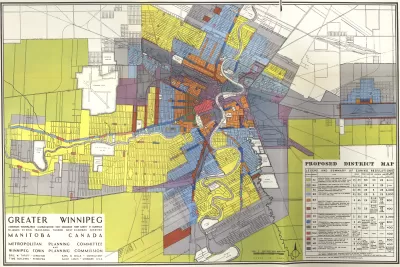Strict separation of uses may be an inefficient way to zone dynamic modern cities.

Scott Beyer argues that current zoning codes impede the adaptive reuse of buildings that used to house offices and large retail, stifling a major potential source of supply that could feed the rising demand for industrial warehousing and residential uses. "Reforming such laws will be crucial for cities that want to stay economically dynamic and avoid the scourge of empty buildings," Beyer writes.
"The Wall Street Journal reports that lending for offices has plummeted to 35 percent of 2019 figures." Meanwhile, "[c]onventional retail faces similar trends. Moody’s predicted that retail vacancy nationwide could be as high as 12 percent in 2021 (it was already 10.6 percent for the first quarter)." But despite the "boom in demand for warehouse space" and rising demand for affordable urban housing, most zoning codes "still require that prime ground-level building space be reserved for increasingly obsolescent office and retail uses."
Communities have pushed back on proposed warehouse facilities. "[E]xamples of hostility to Amazon’s last-mile fulfillment warehouse centers have occurred in Denver, Boston and Seattle, while in central California, opponents of a Walmart distribution center called the project a threat to public health due to truck emissions." Beyer counters that "pushing these warehouses far from population centers will worsen the environment by increasing vehicle miles traveled."
Beyer goes on to discuss "perhaps the biggest zoning-caused distortion in modern real estate: housing. Everything about this sector speaks to scarcity," a problem which he partly attributes to "restrictive zoning laws that stifle new housing projects." Beyer suggests changing zoning codes to "allow empty office and retail spaces to be converted into housing," but also poses a broader question of whether land should be zoned by use at all. While land use zoning can provide an important buffer between residential areas and dangerous industrial uses, for example, strict separation of uses may be an outmoded way of zoning for the "ever-evolving" uses of modern cities.
FULL STORY: Modern Zoning Is Incompatible With Modern Needs

Planetizen Federal Action Tracker
A weekly monitor of how Trump’s orders and actions are impacting planners and planning in America.

Map: Where Senate Republicans Want to Sell Your Public Lands
For public land advocates, the Senate Republicans’ proposal to sell millions of acres of public land in the West is “the biggest fight of their careers.”

Restaurant Patios Were a Pandemic Win — Why Were They so Hard to Keep?
Social distancing requirements and changes in travel patterns prompted cities to pilot new uses for street and sidewalk space. Then it got complicated.

Platform Pilsner: Vancouver Transit Agency Releases... a Beer?
TransLink will receive a portion of every sale of the four-pack.

Toronto Weighs Cheaper Transit, Parking Hikes for Major Events
Special event rates would take effect during large festivals, sports games and concerts to ‘discourage driving, manage congestion and free up space for transit.”

Berlin to Consider Car-Free Zone Larger Than Manhattan
The area bound by the 22-mile Ringbahn would still allow 12 uses of a private automobile per year per person, and several other exemptions.
Urban Design for Planners 1: Software Tools
This six-course series explores essential urban design concepts using open source software and equips planners with the tools they need to participate fully in the urban design process.
Planning for Universal Design
Learn the tools for implementing Universal Design in planning regulations.
Heyer Gruel & Associates PA
JM Goldson LLC
Custer County Colorado
City of Camden Redevelopment Agency
City of Astoria
Transportation Research & Education Center (TREC) at Portland State University
Camden Redevelopment Agency
City of Claremont
Municipality of Princeton (NJ)





























